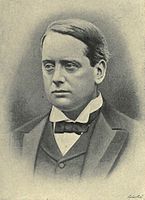Liberal government, 1892–1895
Rosebery led the Government from 1894. He was defeated in the 1895 general election.
In the 1892 general election, the Conservative Party, led by the Marquess of Salisbury, won the most seats but not an overall majority. As a result, William Gladstone's Liberal Party formed a minority government that relied upon Irish Nationalist support. On 3 March 1894, Gladstone resigned over the rejection of his Home Rule Bill and the Earl of Rosebery succeeded him.
Cabinets
Fourth Gladstone ministry
Fourth Gladstone ministry | |
|---|---|
| 1892–1894 | |
 Gladstone | |
| Date formed | 15 August 1892 |
| Date dissolved | 2 March 1894 |
| People and organisations | |
| Monarch | Victoria |
| Prime Minister | William Gladstone |
| Member party | Liberal Party |
| Status in legislature | |
| Opposition party | Conservative Party |
| Opposition leaders | |
| History | |
| Election | 1892 general election |
| Legislature terms | 25th UK Parliament |
| Predecessor | Second Salisbury ministry |
| Successor | Rosebery ministry |
Rosebery ministry
Rosebery ministry | |
|---|---|
| 1894–1895 | |
 Rosebery (c. 1895) | |
| Date formed | 5 March 1894 |
| Date dissolved | 22 June 1895 |
| People and organisations | |
| Monarch | Victoria |
| Prime Minister | Lord Rosebery |
| Member party | Liberal Party |
| Status in legislature | |
| Opposition party | Conservative Party |
| Opposition leaders | |
| History | |
| Legislature terms | |
| Predecessor | Fourth Gladstone ministry |
| Successor | Third Salisbury ministry |
Changes
- May 1894 – James Bryce succeeds A. J. Mundella at the Board of Trade. Lord Tweedmouth succeeds Bryce at the Duchy of Lancaster, remaining also Lord Privy Seal.
List of ministers
Cabinet members are listed in bold face.
- Notes
- ^ Also Leader of the House of Commons.
- ^ Also Leader of the House of Lords.
- ^ Also Leader of the House of Commons 1894–1895.
- ^ Succeeded as 2nd Baron Tweedmouth 4 March 1894.
- ^ Also Leader of the House of Lords 18 August 1892 –
5 March 1894.
References
- D. Butler and G. Butler (ed.). Twentieth Century British Political Facts 1900–2000.



